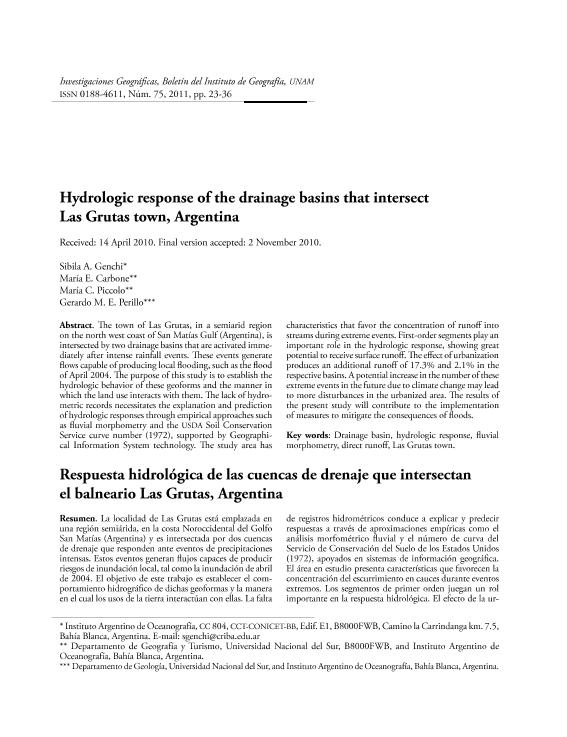Artículo
The town of Las Grutas, in a semiarid region on the north west coast of San Matías Gulf (Argentina), is intersected by two drainage basins that are activated immediately after intense rainfall events. These events generate flows capable of producing local flooding, such as the flood of April 2004. The purpose of this study is to establish the hydrologic behavior of these geoforms and the manner in which the land use interacts with them. The lack of hydrometric records necessitates the explanation and prediction of hydrologic responses through empirical approaches such as fluvial morphometry and the USDA Soil Conservation Service curve number (1972), supported by Geographical Information System technology. The study area has characteristics that favor the concentration of runoff into streams during extreme events. First-order segments play an important role in the hydrologic response, showing great potential to receive surface runoff. The effect of urbanization produces an additional runoff of 17.3% and 2.1% in the respective basins. A potential increase in the number of these extreme events in the future due to climate change may lead to more disturbances in the urbanized area. The results of the present study will contribute to the implementation of measures to mitigate the consequences of floods. La localidad de Las Grutas está emplazada en una región semiárida, en la costa Noroccidental del Golfo San Matías (Argentina) y es intersectada por dos cuencas de drenaje que responden ante eventos de precipitaciones intensas. Estos eventos generan flujos capaces de producir riesgos de inundación local, tal como la inundación de abril de 2004. El objetivo de este trabajo es establecer el comportamiento hidrográfico de dichas geoformas y la manera en el cual los usos de la tierra interactúan con ellas. La falta de registros hidrométricos conduce a explicar y predecir respuestas a través de aproximaciones empíricas como el análisis morfométrico fluvial y el número de curva del Servicio de Conservación del Suelo de los Estados Unidos (1972), apoyados en sistemas de información geográfica. El área en estudio presenta características que favorecen la concentración del escurrimiento en cauces durante eventos extremos. Los segmentos de primer orden juegan un rol importante en la respuesta hidrológica. El efecto de la urbanización produce un efecto adicional del 17.3 y 2.1% de escurrimiento en cada cuenca. El incremento potencial del número de eventos extremos en el futuro debido al cambio climático, podría conducir a mayores perturbaciones en el área urbanizada. Los resultados contribuirán a implementar medidas que mitiguen posibles consecuencias de los peligros de inundación.
Hydrographic behavior of the drainage basins that intersect Las Grutas town, Argentina
Título:
Respuesta hidrológica de las cuencas de drenaje que intersectan el balneario Las Grutas, Argentina
Genchi, Sibila Andrea ; Carbone, Maria Elizabeth
; Carbone, Maria Elizabeth ; Piccolo, Maria Cintia
; Piccolo, Maria Cintia ; Perillo, Gerardo Miguel E.
; Perillo, Gerardo Miguel E.
 ; Carbone, Maria Elizabeth
; Carbone, Maria Elizabeth ; Piccolo, Maria Cintia
; Piccolo, Maria Cintia ; Perillo, Gerardo Miguel E.
; Perillo, Gerardo Miguel E.
Fecha de publicación:
02/2011
Editorial:
Universidad Nacional Autónoma de México. Instituto de Geografía
Revista:
Investigaciones Geográficas
ISSN:
0188-4611
Idioma:
Inglés
Tipo de recurso:
Artículo publicado
Clasificación temática:
Resumen
Palabras clave:
Drainage Basin
,
Hydrologic Response
,
Fluvial Morphometry
,
Las Grutas
Archivos asociados
Licencia
Identificadores
Colecciones
Articulos(IADO)
Articulos de INST.ARG.DE OCEANOGRAFIA (I)
Articulos de INST.ARG.DE OCEANOGRAFIA (I)
Citación
Genchi, Sibila Andrea; Carbone, Maria Elizabeth; Piccolo, Maria Cintia; Perillo, Gerardo Miguel E.; Hydrographic behavior of the drainage basins that intersect Las Grutas town, Argentina; Universidad Nacional Autónoma de México. Instituto de Geografía; Investigaciones Geográficas; 75; 2-2011; 23-36
Compartir
Altmétricas



